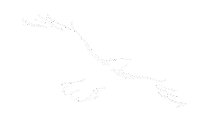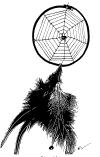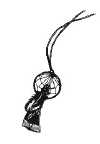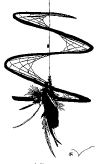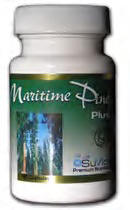Interpreting the Pictographs of North Hegman Lake, MN
Kevin L. Callahan
Department of Anthropology
University of Minnesota
Introduction
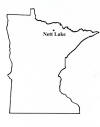 Some
of the best known and most photographed pictographs in the Upper Midwest are
located at North Hegman Lake, northwest of Ely, MN, in the Boundary Waters
Canoe Area Wilderness on a granite cliff overlooking the water. This rock
art is located within the "northern woodlands" stylistic rock art region of
Campbell Grant (1983) and Klaus Wellmann (1979).
Some
of the best known and most photographed pictographs in the Upper Midwest are
located at North Hegman Lake, northwest of Ely, MN, in the Boundary Waters
Canoe Area Wilderness on a granite cliff overlooking the water. This rock
art is located within the "northern woodlands" stylistic rock art region of
Campbell Grant (1983) and Klaus Wellmann (1979).
The panel shows a human figure in an outstretched arms
posture standing near a quadruped animal with a long tail, possibly a dog or
wolf, and a remarkably well drawn bull moose with splayed hooves and dew
claws. (A dew claw on a moose is a reduced hind toe or the false rudimentary
hoof above the true hoof .) Beneath these figures is a long horizontal line,
probably representing the ground or horizon, and above the human figure are
two vertical rows of short horizontal lines or dashes. One set has 4 lines
and next to it are 3 lines. Above and to the right are what look like three
canoes. The top two canoes have two paddlers and the third has a faint
single one in the middle. Above the moose's rack is a single mark. Above all
of these figures is a large cross like a "plus" sign.
Several feet to the left of the scene are other much more
faint pictographs including 6 horizontal lines, one above the other, three
crosses above each other, and a "Y" shaped figure with a "C" shape to it
with diagonal strokes. There may also be a spiral and grid-like figure near
the water.
The arrangement of figures at the main panel of the North
Hegman Lake, Minnesota rock art site appears to have been carefully composed
at one time by one rock artist. After examining the pictographs from about a
foot away, it appears that the application of the red ochre was relatively
recent, since it hardly looks weathered compared to other similar red ochre
pictographs in northern Minnesota. It is also possible that someone has
carefully reapplied ochre to a much older pictograph.
Although experiments have shown that red ochre on a rock
face can become sealed through natural processes and remain quite bright
even when very old, I saw no particular indication from looking at the panel
up close that it was naturally encapsulated or sealed; however, I have not
viewed it under magnification nor conducted any sort of microscopic
examination of the surface.
The most likely candidates for the cultural groups who
were making red ochre pictographs with these kinds of figures during the
historical period were the Ojibwe and Cree. Other similar sites in the
region have been investigated by researchers like Thor Conway (1993), Selwyn
Dewdney and Kenneth Kidd (1973), Henry R. Schoolcraft (1851), Grace
Rajnovich (1994) and others. Most of the other recent red ochre pictographs
in this area appear to have been made by Ojibwe individuals who were
recording shamanistic dreams and visions and Ojibwe leaders who were
recording their biographical exploits.
The panel's anthropomorphic figure is painted with an
"outstretched arms" posture rather than an "upraised arms" posture. Henry R.
Schoolcraft, an Indian Agent whose wife was half Ojibwe and whose
mother-in-law was a full-blood Ojibwe, authored a multi-volume work called
Historical and Statistical Information . . . of the Indian tribes of the
United States published in 1851. According to Schoolcraft, in
pictographic inscriptions used in hunting, an anthropomorph with upraised
and outstretched arms "depicts a Meda [shaman]. He is about to open his
performances, and appeals to the candor and sympathy of his fellows.
. . . Behold me, Medas, my friends. Unishenauba (or the
common people.) Question me my friends (Schoolcraft 1851:vol.1:383-384).
According to Schoolcraft, in Ojibwe birch bark scroll
pictography "friendship [is shown] by an open hand" (Schoolcraft 1851:
vol.1:420).
An upraised arm posture was a widely known position of
prayer assumed by Native Americans in many areas of North America. According
to Albert Reagan (1958), the Indian Agent at Nett Lake, Minnesota from
1909-1914, it was also associated with a dance posture of Ojibwe medicine
men and women, especially when the legs were slightly bent. It also can mean
supernatural being.
Selwyn Dewdney and Kenneth E. Kidd (1973) in their book
Indian Rock Paintings of the Great Lakes
described a huge, detached slab of granite below the Hegman
Lake pictographs, which produced a dull hollow sound when tapped with a
rock.
Sound may have been a component in the selection of rock
art sites in Minnesota. For example, in describing the petroglyphs at Nett
Lake in northern Minnesota, Albert B. Reagan reported that Spirit Island or
"Picture Island," where the petroglyphs were located, was also sometimes
called "Drum Island" by the Ojibwe because "the polished rock area is hollow
beneath; and, on walking over it, it gives out a hollow drum-like sound"
(Reagan 1958).
A review of culturally specific ethnohistoric sources,
analysis of the rock art, and specific information about the night sky
suggest that this panel probably represents an accurate drawing of the
Ojibwe winter constellation. Like the Ptolemaic system of constellations,
Ojibwe constellations had many rich associations with stories, myths, and
legends.
1 -
2
-
3 -
4 -
5
-
6
White Eagle Soaring: Dream Dancer of the 7th Fire

Index of DreamCatchers However
You Spell DreamCatcher
However you've spelled Dream Catcher, these REAL Dream Catchers are
natural magic from Creator Direct (Manidoog).
